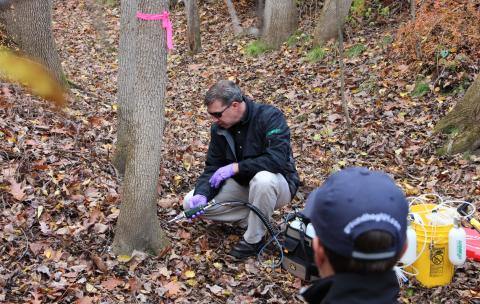When to Treat Your Ash Trees to Protect Against Emerald Ash Borer (EAB)

Here at NHBugs, we are often asked the question, “Should I treat my ash trees to protect against emerald ash borer (EAB)?” Our answer always begins with, “It depends.”
It depends on …
- where in New Hampshire you are.
- how valuable is the ash in question.
- where the tree is on the landscape.
- how healthy the tree is to begin with.
Start with an inventory of your ash trees
Unless your trees are already infested, there is no need to panic since it takes several years for EAB to kill infested trees—but it’s important to get ready. Start with an inventory of your property (or park, or town streets, etc.). Designate trees for removal or treatment and record the diameter of trees. This can help with budgeting since treatment costs are often figured on a per inch of diameter basis.
Where are you in New Hampshire?
Knowing where you are in relation to the known infestations will help you decide if you should even consider treating. The decision to treat—or not to treat—should be informed by where you are in relation to where EAB is known. New Hampshire is split into three management zones and we update the map of the EAB zones every time we find a new infestation.
If you are in the “green zone,” it is too early to treat. The most effective and safest chemical is emamectin benzoate (EB) which is injected into the tree. Though effective, injections wound the tree, so it is best to time the wounding when the chemical is really needed. Injecting the tree years before EAB arrives won’t provide added protection.
If you are in the orange zone, you can either treat your trees preventatively now, or wait and closely monitor the trees for signs and symptoms of EAB and treat as soon as you see those signs and symptoms. Blonding on ash is a tell-tale sign your tree is infested with EAB.
If you are in the red zone, you should be treating any valuable trees you want to save.
Deciding how valuable the ash tree is and where is it on the landscape?
For the most part, treating trees on a woodlot isn’t practical, financially or otherwise. But in your yard or along your town streets, parks, cemeteries or other public places, the value is in the eye of the beholder. Sentiment, aesthetics, and shade can all be priceless as is the tree providing them.
A tree’s location might provide some financial reasons for treating—a big ash in a fenced-in backyard with powerlines could cost several thousand dollars to remove, whereas you might be able to treat it for a few hundred dollars every few years…and still have your tree.
How healthy is the tree to begin with?
The crown (top) of the tree helps move water and nutrients (and applied chemicals) into and through the tree. We say that at least 50% of the crown needs to be alive for effective treatment, but even more living top is better.
Knowing where the EAB infestation is by using the map and also monitoring your ash trees frequently will help you start treating valuable ash before their tops decline too much for treatment to be effective.
Three Approaches to Take
There is no “one size fits all” answer to the question of to treat or not. You can take three different approaches for each ash tree as EAB arrives on the scene:
- Treat (now or later)
- Remove (now or later)
- Do nothing, realizing the tree will die and fall down, eventually
What if you decide to treat your tree?
Trees with less than 50% dieback and ones you consider valuable, for example because of their location or sentimental value, are candidates for treatment. Here are some resources for you to consider if you have trees you want to treat:
- Selecting Trees for EAB Treatments
- Find a licensed pesticide applicator to treat your ash trees.
- Using Insecticides to Safeguard Individual Trees Against Emerald Ash Borer
What if you decide to take down your ash?
Most ash with more than 50% dieback should be taken down since treatment will be ineffective. Here are resources for you to consider if you decide to take them down:
- Find a certified arborist to prune, care for or remove your ash trees.
- Tree Work Contract
- Don’t move any of the wood cut from the ash trees more than 5 miles from where it’s cut (recommended), so this can be a good source of homeowner firewood. State law requires that it not be moved outside of the quarantine zone (see map).
What if you decide to do nothing—a caveat
Ash trees tend to break apart quickly once dead. If a tree is in your yard and near areas where people regularly walk under them, doing nothing may prove disastrous. However, doing nothing with an ash tree in your woods may be a different story.
In the end, this is a decision that only you as the landowner can make.

